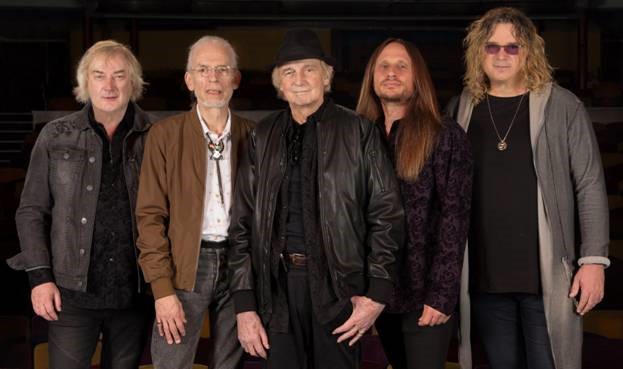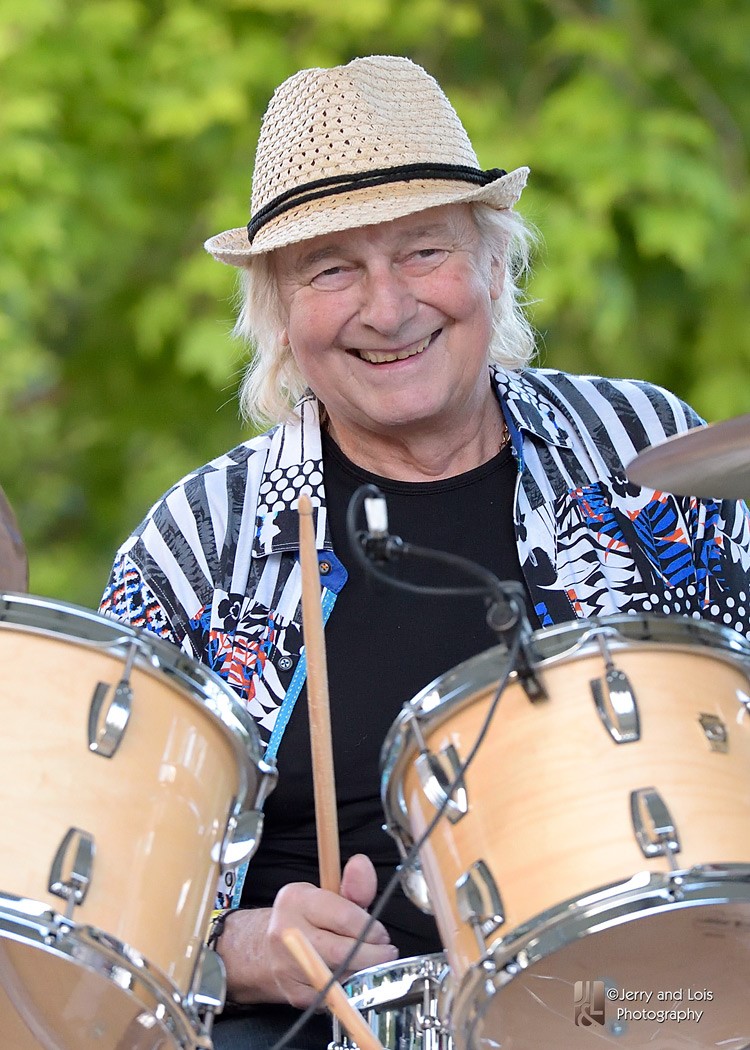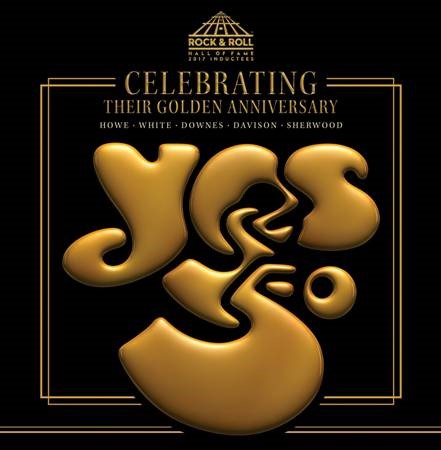50 Years of Yes: In the Studio and Live with Drummer Alan White
Crossing paths with your heroes. When those rare chances arrive, it’s a reminder of why I worked so hard to become a music journalist.
I seized just such a moment recently, when the opportunity arose to interview Alan White, the drummer for Yes. As an awkward teenager taking lessons in the musty backroom of Royal Music in Royal Oak, Michigan, I would gaze up every week at his poster right above the practice pads. Pecking out paradiddles for my grouchy teacher, I would dream of being a rock star like that guy.
Of course, I never came close (not for lack of trying). And while Alan White and I never shared a big stage, we did share a phone line in real time, which three decades later feels like more than enough. With his precision, power, creativity and feel, White has firmly established himself as one of modern music’s premier musicians.
As have his bandmates, who have been touring all summer for their 50th Anniversary tour, #YES50: Celebrating 50 Years of YES (happening this Sunday, July 15th at Staten Island’s St. George Theatre and continuing on through July 28th. White is joined on the 35-date tour by founding member/Grammy winner/Rock & Roll Hall of Fame inductee Tony Kaye (keyboards; 1968-1971 and 1983-1995), Steve Howe (guitar since 1970), Geoff Downes (keyboards; first joined in 1980), Jon Davison (vocals since 2011) and Billy Sherwood (guitar/keyboards in the 1990’s, as well as the late Chris Squire’s choice to take over bass/vocals in 2015). White himself knows the ropes pretty well, having taken over for Bill Bruford on drums in 1972.
Coinciding with the tour is the June 29 release of YES: The Steven Wilson Remixes, as a five-album vinyl set featuring Wilson’s remixes of five classic YES studio albums: The Yes Album (1971), Fragile (1971), Close To The Edge (1972), the double album Tales From Topographic Oceans (1973) and Relayer (1974). Released on vinyl for the first time, each album features remixed audio by Steven Wilson, plus a host of new and artwork created specifically for the set by Roger Dean, with new cover art for Close To The Edge and Tales From Topographic Oceans and reworked art by Dean for the remaining three covers. YES also recently issued Fly From Here – Return Trip, a new version of their 2011 album Fly From Here featuring the Drama lineup and new lead vocals by Trevor Horn.
The GRAMMY-winning prog-rock progenitors were founded in 1968 by Squire and Jon Anderson, going on to create massively influential songs like “Roundabout,” “Close to the Edge,” “I’ve Seen All Good People,” “Owner of a Lonely Heart,” and many more. Those unique tracks were the engine for an incredible 50 million+ album sales, including Fragile, Close to the Edge, Tales from Topographic Oceans, Relayer, Going For the One and 90125.
Yes is playing many of their fan’s favorites, plus some deeper-cut classics, throughout #YES50. As White confirms below, it’s a mindblow of a set list that keeps him constantly challenged. His insights on the big task of delivering live on Yes’ beloved studio classics, satisfying John Lennon for the recording of his iconic album Imagine, and more are coming up next.
Alan, the first question I wanted to ask is, how do you work with the live sound crew to get your drum sounds to translate the way you’d like? How would you characterize how you want your drums to sound for the current tour?
Well the drum kit sounds pretty, it’s pretty hard-hitting, kind of real solid foundation type sound of the drum kit. It supports the band in many ways. The sound guy that we actually have, he’s been with us for years. He knows exactly how to mic them and get that sound. He uses all the right mics. He always has and he just knows what I like.
Is there a way you would characterize you like the way the drums to sound? Are you going for a studio sound? Or what’s that extra oomph that you can get from a kit when it’s live?
The studio sounds sometimes totally different. It all depends on the song really. But the stage is one particular sound, but so is the auditorium and it makes the band sound good.
Staying on that tip, Yes has so many classic songs in its repertoire, which means their fans have heightened expectations for the songs to closely match the studio recordings when they hear them live. To what extent does Yes go to meet those expectations? To deliver a studio sound live?
Not really. We have a general sound that applies to most songs. In the studio, you really adjust the sounds for the song basically. But I’ve gotten a reputation for having a pretty big drum sound in the old days, so usually it’s around the same area.
Alan, for 2017’s YESTIVAL tour, it struck me that you were playing live with another drummer, Dylan Howe, Steve Howe’s son. To many people, drummers and non-drummers alike, performing live alongside another drummer seems like a particularly challenging task. Had you done that before?
Yeah, I’ve done it quite a few times. When you play with another drummer you have to be very forgiving in your playing and let him have certain areas and you take certain areas and you work it out between the two of you.
The first guy that I worked with was Jim Keltner, actually. I did a tour with Joe Cocker in 1970 or thereabouts. Mad Dogs and Englishmen, it was called.
When you say forgiving, what do you mean? I know it would be very hard for me to play live with another drummer.
You have to listen well to the other drummer. That’s the secret basically. And be in tune, both on the same page all of the time. It sounds like a train wreck otherwise.
Can you think of other two-drummer combos that you’ve seen that you really enjoyed?
The Allman Brothers guys [Butch Trucks and Jai Johanny “Jaimoe” Johanson] used to play together years ago were superb at it. I mean, they were very compromising with each other and they both sounded great. It was almost like one huge drum performance. Really, really great playing and really paying attention to the other guy.
“It’s Always Exciting”
Absolutely. Alan, when a band has been around as long as Yes has, member turnover is practically inevitable. What is your response to critics who might say that the iteration of Yes performing today is not truly Yes given its extensive evolution, personnel-wise, to what it is now?

Yes (L-R): Geoff Downes, Steve Howe, Alan White, Jon Davison, and Billy Sherwood
(Photo Credit: Gottlieb Bros.)
Actually, myself and Steve, well, everybody calls us original members, but prior to me there was Bill Buford in the band for a few years. He left to form King Crimson.
So Steve and myself are playing and then we have a singer called Jon Davison who’s excellent. He actually sounds rather like Jon Anderson. Then there’s Billy Sherwood. Chris is his mentor, so he pretty much knows everything that Chris ever did. Then on keyboards we have Geoff Downes who’s been in the band for a number of years now. He was originally in the band in 1981, I believe. That’s when we did the album Drama.
Is it still exciting to you to play these songs? You’ve been playing some of them for decades.
Yeah, of course it is. It’s always exciting to play Yes music. It’s a challenge on a nightly basis to perform everything properly and get everything in the right place. It’s just a demanding kind of role. Especially because of the drumming. If the drummer gets it wrong they all do.
From Drama to Imagine and 90125: A Life of Studio Highlights
Alan, switching gears to the studio, which album or albums in Yes’ extensive discography do you feel has the best fidelity in terms of the quality tracking, mix or the master for the band and the drum sound?
A lot of them, actually. I think Drama was an exceptionally well recorded album. Then, I thought Relayer, was an album in ’76, that was a really well recorded album. 90125 was exceptional in sound, I thought. It was one of the best albums we did as far as sonic that I played.
I go crazy every time “Owner of a Lonely Heart” comes on the radio. What a once-in-a-lifetime song that is. Your performance on there is so massively inspiring to me.
Well, thank you very much.
You’ve had the privilege of recording for decades, in which time the process has seen great change. In your opinion, what has changed most about studio recording since your career began? What remains fundamentally the same?
Obviously, everything has progressed incredibly since the 70’s. I think one of the most important is the mixer board, they’re all upscaled now. And you get these boards, I mean, we’ve done some recording in a studio in L.A. where they had a huge Neve board. It was half analog and half digital so you could actually record the basics on an analog and also overdub digital right on the same machine. So, it’s kind of interesting that way.
Not everybody knows that you’ve recorded with many other musical greats outside Yes, including John Lennon on Imagine. How would you characterize the experience of those sessions working with Lennon? What did he expect from his band?
John Lennon was really incredible to work with. He was very easy, really. I was only 20 years old when I made that album so I just remember John saying to me, “Whatever you’re doing, it sounds great. Just keep doing it.” So he was easy to work with in that way. He wasn’t awkward and demanding. He let it flow and that’s what I hear in the album Imagine. Everybody expresses exactly what they feel.
The Drummer’s Drummers
Alan, you’ve been an inspiration to many generations of drummers. Which drummers stand out most to you as inspiration? Either recorded or live?
Well, a lot of things. When I was in my teens I was very into listening to a lot of fusion-type drummers like Lenny White, Alphonse Mouzon. All of those guys were very inspirational in the ways to sway. You got a rock ‘n roll style but you could do all of the other tricky, little uptime signatures and different things like that.
So, those kind of drummers from that era. Plus, of course, Ringo Starr, The Beatles. He was solid, provided what was needed to the music.
Yes, the closer you listen to his parts today, the more is revealed to me every time. Ringo is really incredible. Here’s my last question: How would you characterize the evolution of progressive music today? Have you been surprised by the directions it’s taken since Yes was at the forefront of the genre?
I think all kinds of styles of music go in big circles. Progressive music was very evident. 20, 30 years ago people were doing things like that. Even 50 years ago because Yes was considered progressive but, in the end it goes out of style like any other music but then it all comes back again. Just like the way LPs turned into CDs and now everybody’s switching back to cassettes. Which is kind of a big roundabout.
The #YES50 tour runs through July 28. Visit here for tour dates.
— David Weiss
Please note: When you buy products through links on this page, we may earn an affiliate commission.








